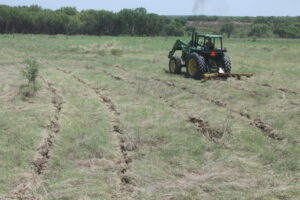Project Overview
Commodities
Practices
- Animal Production: grazing - multispecies, grazing - rotational, range improvement, rangeland/pasture management, stocking rate, watering systems
- Education and Training: demonstration, extension, farmer to farmer, networking, on-farm/ranch research, workshop
- Natural Resources/Environment: biodiversity, carbon sequestration, drift/runoff buffers, habitat enhancement, soil stabilization, wetlands, wildlife
- Production Systems: holistic management
- Soil Management: organic matter, soil analysis, soil chemistry, soil microbiology, soil quality/health
Summary:
Building a successful and sustainable agriculture business presents an abundance of challenges, but during the drought of 2011 we quickly realized our greatest challenge and limiting factor would be water – or the lack thereof. Drought and dry cycles are inevitable and are a result of climatic variability. Water is undoubtedly one of the most critical conservation issues of our time due to our growing population and increased pressures on our natural resources. Finding effective, affordable, and replicable methods to capture and store water on the landscape is essential not only for livestock producers such as ourselves, but for the effective long-term use of our water resources which is relevant to everyone. Subsoiling, or deep soil ripping, is a method of cutting and opening the soil with a subsoiling plow most often to break hard pans and reduce compaction. This practice is used in cropping systems but less frequently on perennial pastures. Subsoiling plows range in price based on design, but the cost of implementing this technique is minimal. In 2014 we began subsoiling pastures and the recovery was incredible. Within half a year and after receiving 6 inches of rainfall, the bare ground was reduced drastically and grass was well established exactly where we had ripped. This positive anecdotal evidence encouraged us to conduct further research to better understand this tool and its impact on the land.
To determine subsoiling's ability to improve water capture on rangelands, this study examined soil and vegetation response to subsoiling on two sites with similar soil textures (clay loam) located at Parker Creek Ranch in D’Hanis, Texas. Measurements included hydraulic conductivity at saturation, compaction, soil chemistry and microbiology, and vegetative ground and standing cover, species composition, and biomass. Strong evidence from this project and other related research indicates that subsoiling can be an effective method to capture and store water on landscapes because of increased rain infiltration. Although enhanced infiltration cannot make up for low organic matter, it can improve plant growth if other soil factors are adequate. Similar to other management techniques, implementation requires careful consideration of your goals and a systematized approach to management.
Tractor pulling the subsoil plow equipped with two 29” shanks.
Project objectives:
- Determine the effectiveness of subsoiling as a management tool to help capture and store water on the landscape.
- Measure hydraulic conductivity, compaction, soil microbiology and chemistry, vegetative standing and ground cover, species composition, and biomass to gain an understanding of how each factor responds to ripping.
- Produce a variety of education and outreach materials to disseminate project results with landowners, producers, consumers, and agriculture and natural resource consultants/educators with the intention of spreading awareness about landscape-scale water conservation efforts.
